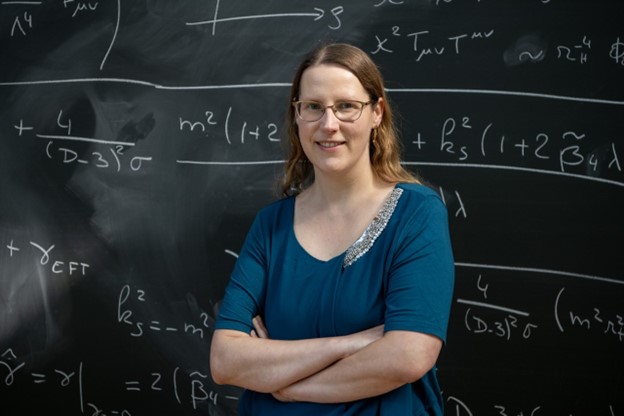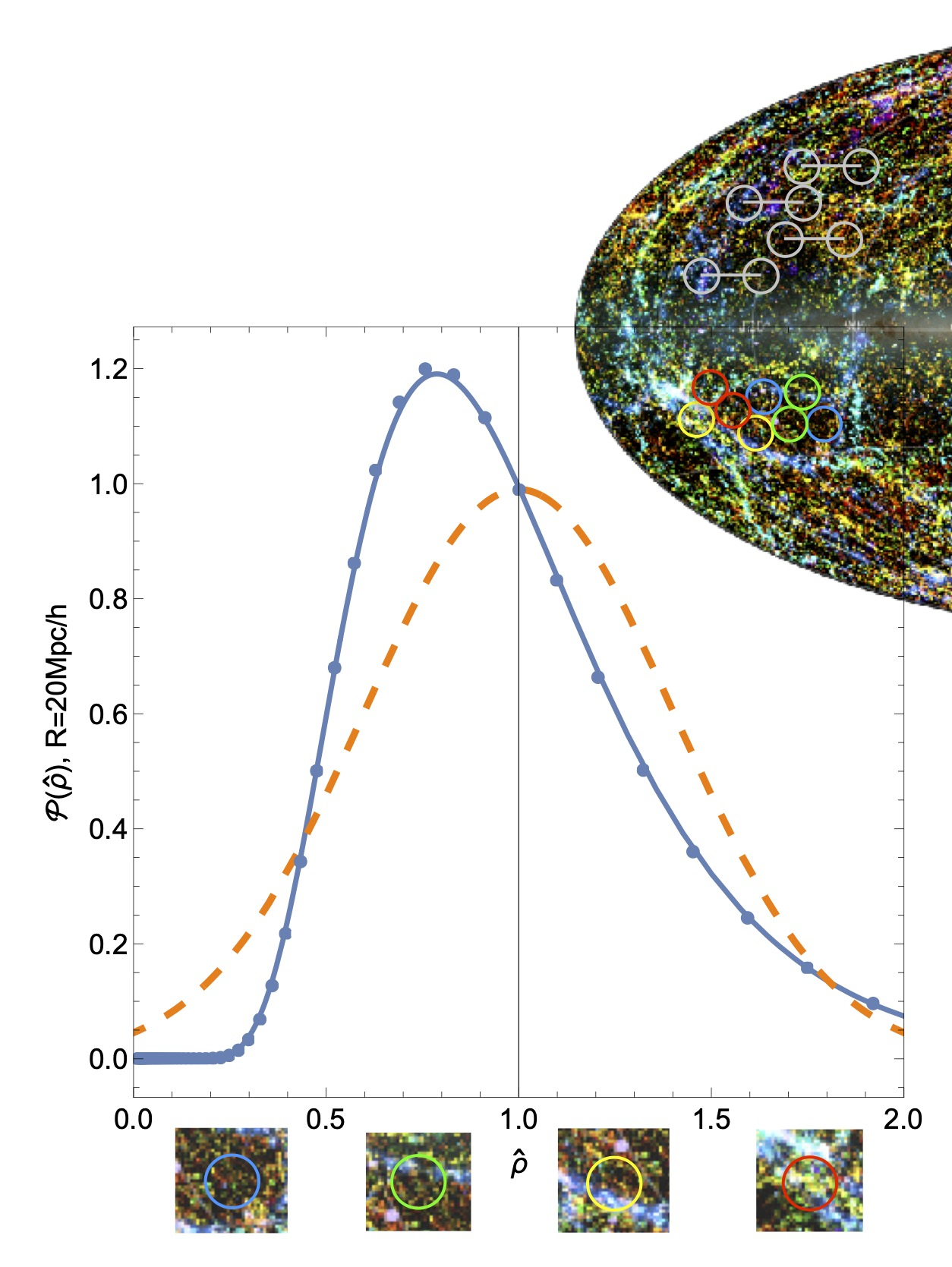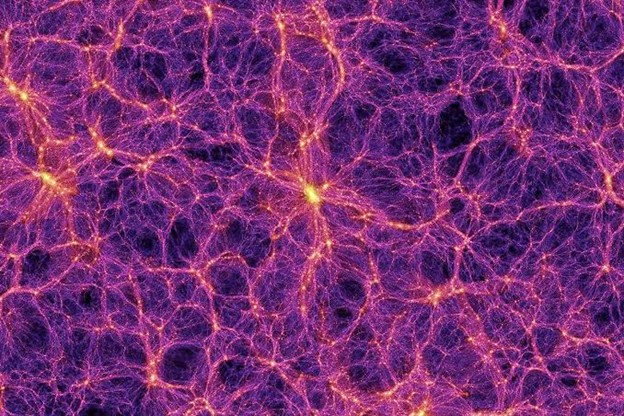About a decade ago, humanity got its best-ever look at the early universe via the European Space Agency’s Planck spacecraft. Planck captured the first light ever to travel freely through the universe – known as the cosmic microwave background (CMB) – at a period about 380 million years after the big bang.
At that time, the universe was highly uniform, with only slight fluctuations in temperature and density.
Fast forward 13 billion years, and those fluctuations have evolved into a vast cosmic web of stars and galaxies.
“Those tiny differences around the mean density seeded all of the structure we see today,” says Cora Uhlemann, a cosmologist at Bielefeld University and a Simons Emmy Noether Fellow at Perimeter Institute.
“Galaxies seem to align along some kind of web-like skeleton. Now the challenge is to understand how we got from the observed initial conditions – basically a close-to-random distribution of matter – to this web-like structure of galaxies.”
To deal with this challenge, the field of cosmology is about to enter its ‘big-data’ era. Just as Planck revealed the early universe, new surveys like the Euclid space telescope and the Vera C. Rubin observatory are about to reveal the near-time universe in unprecedented detail.
There are quite a few mysteries that remain in the story of cosmic evolution. For one thing, normal matter doesn’t seem to be the driving force behind the skeletal cosmic web. Instead, it’s being shepherded into place largely by dark matter, whose invisible presence we’ve only been able to detect due to its gravitational influence.
The nature of dark matter remains unclear. Uhlemann thinks big-data surveys like Euclid could give us some answers, but only if our techniques for analyzing the data are improved.
The thrilling possibilities of ‘one-point’ statistics
If you want to understand how matter – dark or otherwise – is distributed throughout the universe, you’re going to need to do some statistics.
The current standard technique for this problem is known as two-point statistics. It involves picking out all pairs of galaxies with any given separation from a dataset. Essentially, you can think of it as a probability measure as to how likely there is to be another galaxy within a certain distance compared to a random distribution. It is a useless number if you do it just once, for a single galaxy or galaxy cluster, but if you do it millions of times across the universe, you get a nice correlation function showing that galaxies like having company, both nearby, but also across very large distances of about 500 million lightyears.
When cosmologists examined the tiny fluctuations in the CMB, two-point statistics worked almost perfectly. However, the cosmic web underwent complex changes over billions of years, so the technique doesn’t adequately capture the full picture of today’s universe.
“With all these upcoming new exciting surveys, we are going to have a huge amount of data,” says Vilasini Tinnaneri Sreekanth, a PhD student at CAE Paris-Saclay and one of Uhlemann’s collaborators.
“But the problem is, because our universe is evolving, there is a lot of nonlinear information in it, which means that two-point statistics aren't sufficient to gather all the information about the universe.”
That’s where one-point statistics come in. It’s a way to try and handle the more complex structure of the cosmic web. One-point statistics pick out single regions of density in the universe, rather than pairs. Plotting these regions of differing densities alongside one another gives a much more accurate picture of the universe as it is today: most areas are under-dense, with fewer areas that are very dense (and some that are very, very dense). It’s not just a normal distribution anymore – it reveals that most of space is quite empty, with a few areas of superdensity dragging out the right end of the graph.
Predicting nonlinear statistics in the era of precision cosmology is hard. Many statistics are computationally intensive and require expensive simulations. It would be useful to have a unified theory of one-point statistics that all cosmologists can rely on to complement two-point statistics. That’s part of what Uhlemann and her team are working toward.
Gravitational lensing: a challenge and an opportunity
There are other things to think about too. Looking at the universe isn’t like looking at a static photograph. It’s in three dimensions (plus a temporal dimension as you look further away), and there are propagation effects that distort the shape of galaxies and throw off measurements.
Uhlemann’s team is grappling with one effect in particular: weak gravitational lensing, which occurs when massive cosmic structures distort and stretch the appearance of background galaxies around it. It’s a fluke of Einstein’s theory of relativity, showing that matter warps spacetime and bends the paths that light travels to reach us.
Weak lensing complicates things, but it’s also useful, says Lina Castiblanco Tolosa, a postdoctoral fellow at Newcastle University working with Uhlemann. “It makes the images of the galaxies distorted, but you can quantify how much distortion: with one-point statistics, you can extract information from the deflection in the shapes of the galaxies,” she says.
By understanding gravitational lensing, cosmologists can precisely measure the total mass of the matter causing the lensing, the dark matter within it, and the objects behind it.
Challenges remain, however. There’s another phenomenon called ‘intrinsic alignment’ that mimics the appearance of gravitational lensing. When galaxies form, the dark matter around them can pull on them and align them with each other, making them look like they’re being lensed, even if they’re not.
This phenomenon “impacts our theory and limits what we're able to do,” says Carolyn Mill, another member of the research team and a PhD student at Newcastle University. “Intrinsic alignments are a kind of contaminant in the weak lensing signal. The intrinsic shape that galaxies have can get mixed up with a weak lensing signal and confuse the data.”
Mill is looking for ways to get the most out of Euclid’s data, in spite of contaminants like intrinsic alignment.
Dark matter: is it wave-like?
The payoff of all this work might be enormous. Because the structure of the universe is largely dominated by the gravitational effects of dark matter, Uhlemann hopes that studying that structure might help constrain the nature of dark matter itself.
During her time as an Emmy Noether Fellow, Uhlemann had the chance to collaborate with Perimeter physicists, including postdoctoral researcher Simon May, an expert in running dark matter simulations.
The mass of an individual dark matter particle is currently unknown, and it could fall anywhere within a huge range spanning ~80 orders of magnitude.
“We know it must be there. But we have no clue where in the mass range,” says Uhlemann. “I think what's intriguing is that it could be on the very low mass side, and then you could potentially see some wave-like effects on cosmological scales.”
These wave-like effects are the result of quantum mechanics, in which photons of light are known to be able to act like both a particle and a wave. If dark matter is very low in mass, it could do the same. And if it is extremely low in mass, it could have wavelengths that span the size of galaxies.
But if that’s true, then cosmologists might be able to see its effects, and therefore infer whether dark matter is wave-like or not based on how it has structured the cosmic web.
“What I find fascinating is that even if this is not the case, you might still be able to use a wave-like model as a different kind of approximation,” says Uhlemann.
It would be a new alternative to a common modelling trick that uses giant, heavy dark matter particles to represent the collective mass of many.
Whether dark matter is wave-like or not, modelling the possibilities gives cosmologists a new tool in their toolbox to investigate.
Cosmology for all
Uhlemann is proud of the work she and her research group are doing, tackling some of the hardest questions in cosmology. But she is also keen to make sure that the doors are open to anyone who wants to tackle these questions. Her research group comes from all walks of life. Some wanted to be neurosurgeons, others had dreams of being in a rock band – but they were all captivated by cosmology.
No one’s background should ever be a barrier to their scientific pursuits, says Uhlemann, and she is pleased that programs like the Simons Emmy Noether Fellowship exist to make physics and cosmology more accessible.
“I think Perimeter is making a real effort to support diversity in science. Compared to visiting 10 years ago, I see many female faces, even at the faculty level. So I'm quite glad, because when you have visitors here, it sends a great message,” she says.
Tinnaneri Sreekanth agrees, and found her visit to Perimeter encouraging.
“It's a bit difficult to find people of colour in the field that I work on, and it makes me wonder, ‘do I really have a future or not? Can I keep doing this?’ There’s always this question looming over me. So when I see so many people from so many different backgrounds and diverse lives here, it's really great to see, and gives me a bit of reassurance,” she says.
With the era of big-data cosmological surveys ramping up in the coming decade, the world is going to need a steady stream of new scientists passionate about big questions, and expertise in cutting-edge statistical methods and modelling techniques. Uhlemann and her team are ready for the challenge, and are paving the way for a new era in cosmology.
Cosmology is all about expanding human knowledge, and there is no room for leaving the best minds behind. The Simons Emmy Noether Fellowship program is aimed at making physics more accessible for everyone. You can learn more about the program, and find information for next year’s fellowship here.
Lead Image: NASA
About PI
Perimeter Institute is the world’s largest research hub devoted to theoretical physics. The independent Institute was founded in 1999 to foster breakthroughs in the fundamental understanding of our universe, from the smallest particles to the entire cosmos. Research at Perimeter is motivated by the understanding that fundamental science advances human knowledge and catalyzes innovation, and that today’s theoretical physics is tomorrow’s technology. Located in the Region of Waterloo, the not-for-profit Institute is a unique public-private endeavour, including the Governments of Ontario and Canada, that enables cutting-edge research, trains the next generation of scientific pioneers, and shares the power of physics through award-winning educational outreach and public engagement.




